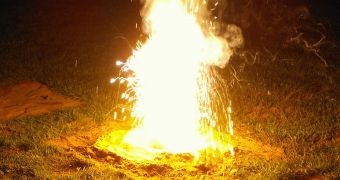It is a substance probably most of us (or at least those who have a passion for pyrotechnics) are obsessed with; stable at room temperature and in normal atmospheric conditions, but extremely violent when ignited. What else could it be, except a pyrotechnic composition? Thermite is basically a powder mix between aluminium and a metal oxide that, when lit, produces an aluminothermic reaction.
It was first fabricated during 1893 by the German chemist Hans Goldschimdt while trying to create a method that would produce extremely pure metal, without using the carbon smelting process. Two years later he realized that the substance has great potential for welding applications, and patented it. Degussa, the world's biggest welding thermite producer today, is in fact a direct descendant from Goldman's original firm.
Although most of the thermite powders produced today are mainly a mix of iron oxide and aluminum, the aluminothermic reaction may allow the use multiple types of metal oxides. A aluminothermic reaction basically takes place when a mixture of aluminum powder and metal oxide is being ignited. During this process, the oxidizing metal, respectively aluminum reacts with the metal oxide in order to form aluminum oxide. The low temperature of the aluminum and its high reactivity determine the reaction to take place in a liquid phase, meaning that the aluminum oxidation is relatively fast and produces very high temperature, more than 2887 degrees Celsius in the case of mixtures containing iron oxide.
Nevertheless, igniting the powder could prove rather difficult. Even while glowing bright red, the substance is stable. Only when it reaches a hot white state the reaction may initiate. Such high temperatures cannot be provided by conventional igniting fuses, but a propane torch could start the reaction.
In the majority of cases, the reaction is initiate with the help of magnesium strips which are easy to ignite and produce the required temperature. However, as in the case of the propane torch, which could determine the explosion of the thermite powder, the use of magnesium metal is dangerous due to the fact that magnesium is an heat conductor and could initiate the chemical prematurely. Instead, the reaction between the potassium permanganate and glycerine is used as a more safer alternative.
Thermite is routinely used in civilian and military a applications, such as welding railways or in the case of the army as hand grenades to destroy top-secret military items to prevent them from being captured by the enemy. Similar thermite substances have been used even in the famous Manhattan Project in order to obtain ultra-pure uranium to build the first nuclear weapon.
Ok, so now you may ask why people are so fascinated with this material. Well it is a pyrotechnic material, relatively easy to make, easy to find, it burns at extremely high temperatures... what easier way to destroy things?

 14 DAY TRIAL //
14 DAY TRIAL //